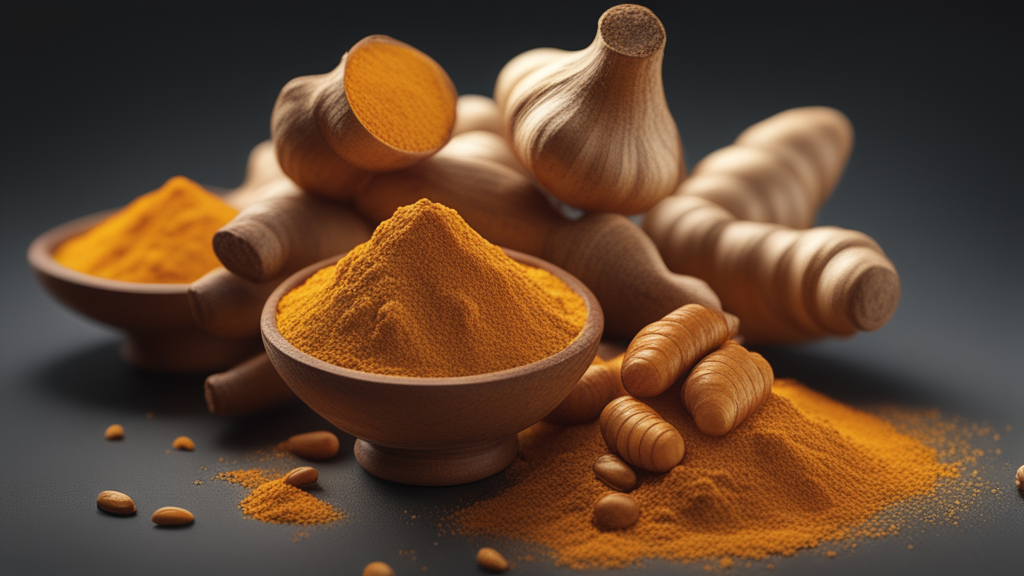When it comes to natural remedies for managing blood sugar, turmeric and its active compound curcumin stand out as powerful options. These ancient spices, known for their vibrant yellow hue, have long been used in traditional medicine, particularly in Ayurvedic and Chinese healing practices. In recent years, modern science has backed up the health benefits of turmeric and curcumin, especially in controlling blood sugar levels and reducing inflammation.
This article delves into the science behind how turmeric and curcumin help regulate blood sugar and why they are effective tools for preventing and managing diabetes.
What Is Turmeric?
Turmeric (Curcuma longa) is a spice that comes from the root of a plant native to Southeast Asia. It is commonly used in cooking, particularly in Indian cuisine, and is known for its distinctive color and flavor. Turmeric contains several bioactive compounds, with curcumin being the most important in terms of health benefits.
Curcumin is the main active ingredient in turmeric and is responsible for many of its medicinal properties. It has strong anti-inflammatory and antioxidant effects, which play a crucial role in managing a range of health conditions, including high blood sugar and diabetes.
The Science Behind Turmeric and Curcumin in Blood Sugar Management
Research has shown that curcumin can have a significant impact on blood sugar levels, insulin sensitivity, and overall metabolic health. Here’s how turmeric and curcumin work to help manage blood sugar:
1. Improving Insulin Sensitivity
One of the key factors in developing type 2 diabetes is insulin resistance, where the body’s cells fail to respond effectively to insulin, resulting in elevated blood sugar levels. Curcumin has been shown to improve insulin sensitivity, allowing the body’s cells to use glucose more effectively and lowering blood sugar levels as a result.
Several studies have demonstrated that curcumin enhances the function of beta cells in the pancreas, which are responsible for producing insulin. By supporting the health and activity of these cells, turmeric can improve insulin regulation and help prevent spikes in blood sugar.
2. Reducing Inflammation
Chronic inflammation is a common underlying factor in many diseases, including diabetes. High blood sugar levels can trigger an inflammatory response in the body, which in turn leads to insulin resistance. Curcumin’s powerful anti-inflammatory properties help reduce the inflammation that contributes to insulin resistance and other metabolic issues.
By lowering inflammation, curcumin helps prevent damage to cells and tissues, thereby improving overall blood sugar control. This makes turmeric an important part of any strategy to reduce the risk of developing diabetes or managing its symptoms.
3. Boosting Antioxidant Activity
High blood sugar levels lead to the production of harmful free radicals, which cause oxidative stress in the body. Curcumin is a potent antioxidant that neutralizes these free radicals, protecting cells from damage and improving metabolic function.
By reducing oxidative stress, curcumin helps protect the body’s tissues, including the pancreas, which is responsible for insulin production. This protection is crucial for maintaining healthy blood sugar levels and preventing the progression of diabetes.
4. Promoting Weight Loss
Maintaining a healthy weight is essential for managing blood sugar levels, and curcumin has been found to support weight loss by enhancing fat metabolism. Turmeric’s role in regulating lipid levels can help reduce body fat, which in turn lowers the risk of insulin resistance and improves blood sugar management.
5. Enhancing Liver Function
The liver plays a critical role in regulating blood sugar by storing glucose and releasing it into the bloodstream when needed. Curcumin has been shown to improve liver function and protect the liver from damage, particularly in individuals with fatty liver disease, a common condition in people with type 2 diabetes.
By improving liver health, turmeric supports more effective blood sugar regulation and overall metabolic function.
How to Incorporate Turmeric and Curcumin Into Your Diet
Adding turmeric and curcumin to your diet is easy and can be done in various ways. Here are some suggestions for incorporating these powerful spices into your daily routine:
1. Turmeric in Cooking
Turmeric is a versatile spice that can be added to a wide variety of dishes. You can include it in soups, stews, curries, and smoothies. Golden milk—a mixture of turmeric, milk (or plant-based milk), and spices like cinnamon and ginger—is a popular way to consume turmeric and benefit from its anti-inflammatory properties.
2. Curcumin Supplements
While turmeric contains curcumin, the concentration is relatively low, so to achieve therapeutic benefits, many people turn to curcumin supplements. These supplements often come in the form of capsules or powders and are typically combined with black pepper (which contains piperine) to enhance absorption. It’s important to choose a high-quality supplement for the best results.
3. Turmeric Tea
Turmeric tea is another excellent way to enjoy the benefits of curcumin. Simply boil fresh or ground turmeric with water and add a dash of black pepper and a sweetener like honey. Turmeric tea can help reduce inflammation, improve digestion, and support blood sugar control.
4. Smoothies and Juices
Add a teaspoon of turmeric powder or fresh turmeric root to your daily smoothie or juice. It pairs well with ingredients like ginger, pineapple, and citrus fruits for a refreshing and health-boosting drink.
Q&A: Turmeric and Curcumin for Blood Sugar Management
Q: How much turmeric or curcumin should I take daily for blood sugar control?
A: For general health benefits, around 500-1,000 mg of curcumin per day is often recommended, but dosages may vary based on individual health needs. If you’re taking a curcumin supplement, follow the manufacturer’s instructions, and consult a healthcare provider, especially if you are managing diabetes or other medical conditions.
Q: Can turmeric cure diabetes?
A: While turmeric and curcumin offer many benefits for managing blood sugar and preventing complications, they are not a cure for diabetes. They should be used as part of a broader approach to managing the condition, including a balanced diet, regular exercise, and medication if necessary.
Q: Are there any side effects of taking turmeric or curcumin?
A: Turmeric is generally safe when consumed in moderate amounts through food. However, high doses of curcumin supplements may cause digestive issues such as nausea, diarrhea, or stomach upset. It’s also important to note that turmeric may interact with certain medications, so it’s always best to consult a healthcare professional before adding large amounts of turmeric or curcumin to your regimen.
Q: Can I take turmeric if I’m already on diabetes medication?
A: Turmeric may enhance the effects of diabetes medication, which could potentially lower blood sugar levels too much. If you are on medication, consult with your healthcare provider before taking turmeric or curcumin supplements to avoid any negative interactions.
Conclusion
Turmeric and curcumin are more than just flavorful spices—they offer significant health benefits, particularly in managing blood sugar levels and reducing inflammation. By improving insulin sensitivity, fighting chronic inflammation, and boosting antioxidant defenses, curcumin can be a valuable addition to a diabetes management plan or a preventative strategy for maintaining healthy blood sugar levels.
Incorporating turmeric into your diet through cooking, teas, or supplements can help you harness its powerful effects. As with any natural remedy, it’s important to consult with a healthcare professional to determine the best dosage and approach for your specific health needs.

Tap Image Above to View Video











